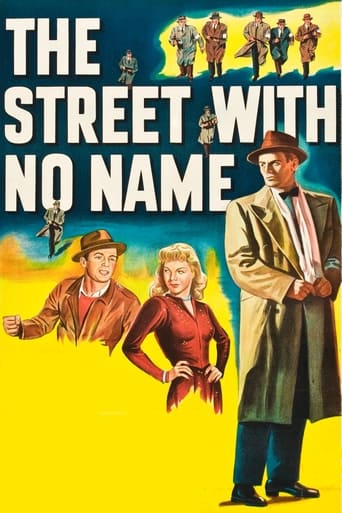bscottcork
Saw this the other night on Movies-TV Film Noir Saturday Night. I read somewhere long ago that legendary director Marty Scorsese was sickly as a child and spent many days at the matinée in his native Brooklyn watching films. I could easily imagine him sitting in a darkened theater around 13 or 14 yrs old and being transfixed by this movie. It reminds me of "The Departed" with all the inside mob and cop snitching, replacing Richard Widmark in the Jack Nicholson role. Excellent caper film.
treywillwest
Film Noir, which has become an almost religious term, allegorically harbored fearful and reactionary attitudes towards women's liberation, radical politics, and the public sphere in general. It implied that post- war American society was morally bankrupt and that the subjects of such a society were doomed to a collective punishment for their lawlessness, for being "led astray" from the traditional "morality" of the patriarchal order. It is thus a fatalistic and thus metaphysical world view. The crime film genre, of which this film is a fine example, those films dealing with the process of the pursuit and capture of criminals by law enforcement, was ironically more progressive and materialistic. Crime was not so much demonized as presented as a byproduct of capitalism, one that law enforcement had to contain. The process of such containment is not romanticized- it is grimy and often boring. But the system works well enough to reproduce itself. "
RanchoTuVu
Organized crime has spread into America's small to mid-sized communities. Not only is it spreading, leader of the Center City crime ring (Richard Widmark), would like to build his organization along "scientific lines", in order to get the most out of crime. This doesn't preclude robbing a bank and then killing the guard, which automatically involves the super-scientific FBI, who eventually plants agent (Mark Stevens) in Widmark's organization. Whose grasp of scientific lines is better? Widmark does OK until the end, and his gang includes B filmmaker and sometime actor Joseph Pevney. The film is actually good enough to overcome its focus on trying to make a hero out of Stevens. The use of voice-over doesn't detract from very fine elements in the film, Widmark being at his best, and cinematographer Joe MacDonald capturing the essence of Center City's mean and damp streets in unsurpassed B&W.
seymourblack-1
"The Street With No Name" is a superior example of the docu-noir style which became so popular in the late 1940s. With its story based on an actual FBI case, real FBI officers taking roles in the movie and the action being shot in the locations where the events actually took place, it's clear that every effort was made to make the end product as authentic and convincing as possible. The result, in this case, is an absorbing thriller which proceeds at a great pace whilst also managing to incorporate some extremely tense sequences.The cinematography by Joseph MacDonald is interesting because it utilises two main styles. The passages featuring the criminals are predominantly shown in shadowy film noir style, whilst those depicting the FBI generally feature a more bland, high key look. Employing these styles, of course, conforms with the traditions of film noir and documentary film making, however, the symbolism involved is also clear.An FBI agent Gene Cordell (Mark Stevens) is furnished with a false identity (George Manly) and a criminal record and given the task of getting into a gang which is suspected of having recently carried out three murders in Center City. Cordell uses his considerable boxing skills to impress gang boss Alex Stiles (Richard Widmark) who also happens to be the owner of a gym where local boxers train. Stiles, who prides himself on running his organisation on "scientific lines", uses a corrupt contact in the Police Department to check on Manly's criminal record and is so impressed by the feedback he receives that he invites Manly to join his outfit.When the Stiles gang plan a robbery at a local mansion, Cordell passes the information back to his colleagues and the FBI and the police jointly stake out the place. The operation has to be aborted however, when Stiles calls off the job after receiving a tip off from his contact in the Police Department. Cordell then goes to the gang's arsenal and locates and fires Stiles' revolver so that forensic tests can be run on the bullet to check if the gun was used in any of the recent murders. Stiles soon realises that his gun has been fired and a fingerprint check that he arranges with his police contact reveals that the gang has been infiltrated by FBI agent Cordell. Stiles' struggle to execute his plan and Cordell's efforts to achieve his objectives, bring the men into deadly conflict in an exciting and action packed conclusion to the story.Mark Stevens gives a solid performance as the confident and courageous Gene Cordell and Richard Widmark is absolutely compelling as a cunning, crafty and neurotic criminal who's convinced of the need to employ increasingly sophisticated methods in order to remain successful. This shrewd side of his character is complemented by an unrestrained brutality which enables him to be both a merciless killer and a violent wife beater.The attention given to the different "scientific" methods used by both the criminals and the FBI provide an unusual and interesting additional dimension to the events depicted and suggest that in 1948, these methods were fully expected to form an important component of any future battles between the worlds of crime and law enforcement.



